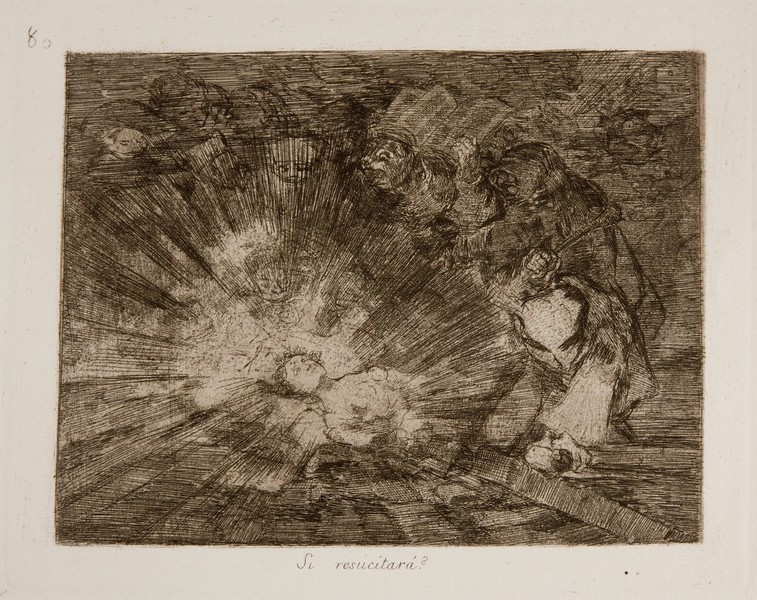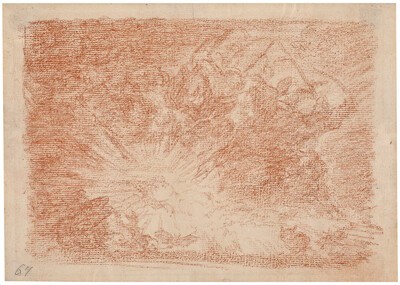- Cronología
- Ca. 1820 - 1823
- Dimensiones
- 178 x 220 mm
- Técnica y soporte
- Etching and burnisher
- Reconocimiento de la autoría de Goya
- Undisputed work
- Titular
- Ailsa Mellon Bruce Collection
- Ficha: realización/revisión
- 06 Jan 2011 / 05 Jun 2023
- Inventario
- 225
See Sad forebodings of what is to come.
The title of the print was handwritten by Goya on the first and only series known to us at the time of its production, which the painter gave to his friend Agustín Ceán Bermúdez. Thus the title was subsequently engraved on the plate without any modification from Ceán Bermúdez's copy for the first edition of the Disasters of War published by the Royal Academy of Fine Arts of San Fernando in Madrid in 1863.
A preparatory drawing of this engraving is in the Prado Museum
The same glowing woman who was being buried in print no. 79, Truth Died, lies in the foreground in this print. The female figure is awakening from her sleep and coming back to life. On the right, where Justice was in print no. 79, Goya has placed a monk holding a stone in one hand and a small trumpet in the other. Next to him is an animal-headed figure with feline features, although it could perhaps be a dog, which in Goya's iconography alludes to greed. Behind him are some figures that resemble vampires. All of them are preparing, in a somewhat threatening attitude, for the awakening of the woman in the engraving, as if they see this as a danger. Only one female figure, strongly illuminated by the halo of light of the woman who is about to be resurrected, seems hopeful.
Various explanations have been put forward for this engraving. In principle, it could be thought that Goya is raising in this image the question of what would happen if the Constitution were to be reintroduced, what all the figures who feel threatened by this possibility might do and how they would defend themselves in such a circumstance. Another interpretation of this print is that the Aragonese painter knew that the Constitution would be reintroduced during the second constitutional period, so he accentuated the verb in the title as if he were certain of the imminence of this event.
Goya may have drawn on various sources of inspiration to create this image. It is possible that the painter was familiar with Psalm 85:11 of the Bible, which states: "Truth shall spring out of the earth; and justice shall look down from heaven". He probably also read the work by Antonio Bernabéu, published in 1820, Spain's Fortunate Spain through the Life of the Constitution and the Death of the Inquisition, in which he wrote: "At last the slumbering reason has awakened and opened the way to the empire of the lights; but it would please God that all nations, sharing abundantly in its salutary influence, had finally shaken off the odious yoke imposed on them by the dark and implacable tyranny of superstition".
Nor should we exclude the possibility that the artist was inspired, as he does in other engravings in this series, by the work of Giambattista Casti (Viterbo or Acquapendente, 1724-Paris, 1803) Gli animali parlanti (1801), in which the return of Truth is announced in a halo of light at the end of the book.
This engraving can be interpreted as a positive contribution to other prints from the Caprichos empháticos in which circumstances that do not augur well are depicted, as can be seen in engraving no. 69, Nothing, It Will Say or in the one that precedes the one we are dealing with here, no. 79, Truth Died. Jesusa Vega points out that this image clearly shows the secularisation of a sacred theme which, in this case, is the Resurrection of Jesus Christ. In this sense, we could speak of a return to engraving no. 1, Sad forebodings of what is to happen, in which the same thing is done with the prayer in the Garden of Olives. This aspect leads us to believe that Goya initially intended this print to be the last in the series.
This engraving can be related to other works by Goya, especially Capricho no. 43, The Sleep of Reason Produces Monsters, in which a positive figure is stalked by a multitude of disturbing and threatening beings.
The plate is in the National Chalcography (cat. 331).
-
De grafiek van GoyaRijksmuseum RijksprentenkabinetAmsterdam1970from November 13th 1970 to January 17th 1971cat. 90
-
Goya. Das Zeitalter der Revolucionen. Kunst um 1800 (1980 – 1981)Hamburger KunsthalleHamburg1980cat. 107
-
Goya y el espíritu de la IlustraciónMuseo Nacional del PradoMadrid1988from October 6th to December 18th 1988. Exhibited also at Museum of Fine Arts, Boston, January 18th to March 26th 1989; The Metropolitan Museum of Art, Nueva York, May 9th to July 16th 1989, Madrid curator Manuela B. Mena Marqués, scientific directors Alfonso E. Pérez Sánchez and Eleanor A. Sayrecat. 162
-
Francisco Goya. Sein leben im spiegel der graphik. Fuendetodos 1746-1828 Bordeaux. 1746-1996Galerie KornfeldBern1996from November 21st 1996 to January 1997cat. 170
-
Francisco de GoyaMuseo d'Arte ModernaLugano1996exhibition celebrated from September 22nd to November 17th.p.197, cat. 80
-
Das Capriccio als KunstprinzipWallraf-Richartz-Museum,1996from December 8th 1996 to February 16th 1997, exhibited also in Zurich, Kunsthaus, from March 14th marzo 1997 to June 1st 1997 and in Vienna, Kunsthistorisches Museum mi Palais Harrach, from June 29th 1997 to September 21st 1997.cat. 121
-
Francisco Goya. Capricci, follie e disastri della guerraSan Donato Milanese2000Opere grafiche della Fondazione Antonio Mazzottacat. 160
-
Goya en tiempos de guerraMuseo Nacional del PradoMadrid2008consultant editor Manuela B. Mena Marqués, from April 14th to July 13th 2008cat. 119
-
Goya et la modernitéPinacothèque de ParisParís2013from October 11st 2013 to March 16th 2014cat. 119
-
Goya: Order and disorderMuseum of Fine ArtsBoston2014cat. 188
-
2022
-
Goya, grabadorMadridBlass S.A.1918cat. 182
-
Goya engravings and lithographs, vol. I y II.OxfordBruno Cassirer1964cat. 200
-
Vie et ouvre de Francisco de GoyaParísOffice du livre1970cat. 1134
-
Dibujos de Goya: Los álbumesBarcelonaNoguer1973
-
A solution to the enigma of Goya’s emphatic caprices nº 65-80 of The Disasters of WarApollo1978pp.186-191
-
Goya y el espíritu de la IlustraciónMadridMuseo del Prado1988pp.450-451, cat. 162
-
Goya. Arte e condizione umanaNaplesLiguori editore1990lam. 206
-
Catálogo de las estampas de Goya en la Biblioteca NacionalMadridMinisterio de Educación y Cultura, Biblioteca Nacional1996cat. 305
-
El Libro de los Desastres de la GuerraMadridMuseo del Prado2000pp.159-162
-
ParísPinacoteca de París2013p. 159
-
Goya: Order & DisorderBostonMuseum of Fine Arts Boston Publications2014p. 281
-
Goya. In the Norton Simon MuseumPasadenaNorton Simon Museum2016pp. 114-151
-
Museo de Bellas Artes de Badajoz y Diputación de Badajoz2022p. 87

